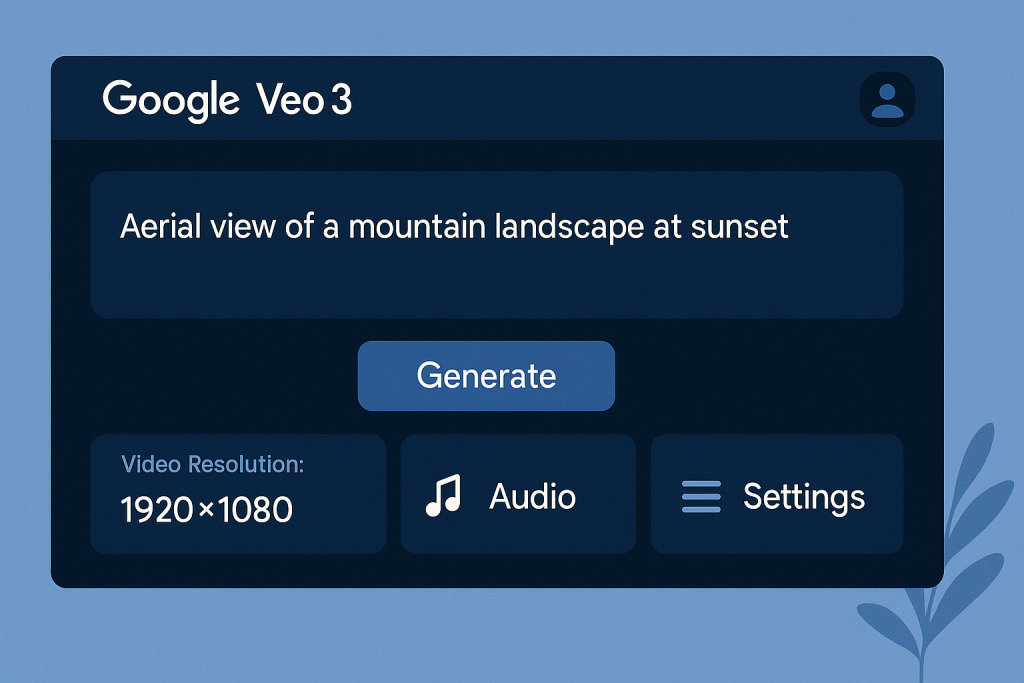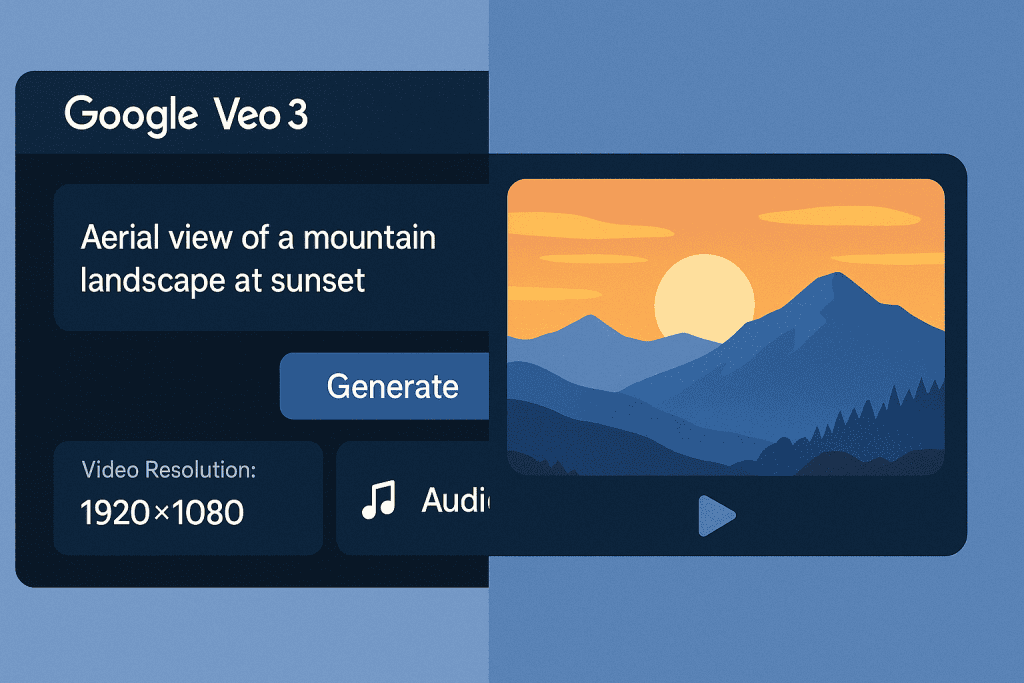
Imagine describing a scene in words and watching it materialize into a cinematic video, complete with synchronized audio and realistic visuals. That’s the promise of Google Veo 3, the latest innovation from Google DeepMind in AI-driven video generation. Building upon its predecessor, Google Veo 2, this new model offers enhanced realism, better prompt adherence, and integrated audio features, making it a powerful tool for creators, marketers, and filmmakers alike.
Overview of Google Veo 3

Google Veo 3 is an advanced AI video generator that transforms text prompts into high-quality videos with synchronized audio. It’s designed to cater to a wide range of users, from professional filmmakers to content creators.
Key Features:
- High-Quality Video Generation: Produces videos with impressive clarity and detail, supporting up to 4K resolution.
- Cinematic Camera Movements: Incorporates smooth pans, zooms, and dynamic tilts, providing a lifelike feel to the videos.
- Integrated Audio: Generates synchronized audio, including dialogue, ambient sounds, and music, enhancing the storytelling experience.
- Prompt Understanding: Accurately interprets text prompts, ensuring the generated video aligns with the user’s vision.
- Stylistic Versatility: Offers various video aesthetics, from cinematic to animated styles, catering to diverse creative needs.
- Extended Video Length: Capable of producing videos up to 60 seconds, allowing for more comprehensive storytelling.
- Editing Capabilities: Provides tools for refining and adjusting generated content, including trimming clips and adding effects.
In-Depth Analysis of Google Veo 3

Google Veo 3 isn’t just another step in AI video technology—it feels like a creative revolution. Whether you’re a filmmaker looking to storyboard scenes, a marketer crafting ad visuals, or a storyteller who just wants your ideas to leap off the screen, this tool is built to translate imagination into motion with unprecedented polish. Let’s take a closer look at how it performs in key areas like design, functionality, and usability.
Design and Interface
The first thing you notice when opening Veo 3 is how clean and intuitive everything feels. Google has clearly spent time making sure the user experience doesn’t get in the way of creativity. The interface is minimal, inviting, and surprisingly easy to navigate—even if you’re brand new to AI video tools.
You type your prompt into a single field, choose stylistic options, and let the magic unfold. From selecting cinematic camera angles to adjusting visual tones, the design strikes a great balance between control and automation. Whether you’re using it within Google Gemini or accessing it through Vertex AI, the platform adapts to different experience levels with grace.
Functionality and Performance
Here’s where Veo 3 really shows off. Unlike previous models, this version generates full 4K resolution video, which is a game-changer if you’re working with larger screens or commercial-grade content. It renders environments and characters with a depth and realism that genuinely feels next-gen.
One standout feature is the inclusion of synchronized audio. Not just generic background music, but ambient sounds, character dialogue, and nuanced audio cues that line up with visual events. This is where Veo 3 starts feeling more like a collaborative film partner than just a generator—it adds layers of immersion that other tools simply can’t replicate right now.
Performance-wise, generation times are surprisingly fast considering the output quality. A 30-second clip can take just a few minutes to render, and the stability of motion, lighting, and continuity between frames is noticeably improved over Veo 2. There’s far less jitter or awkward transitions, making videos feel more cohesive.
Usability
What impressed us most is how Google has minimized the technical barrier. If you can write a sentence, you can use Veo 3. That said, crafting truly great prompts does require some finesse. The more descriptive and vivid your input, the better the result—something that becomes clear the more you experiment.
Still, for a first-time user, there’s no steep learning curve. Built-in guides and sample prompts make it easy to get started, and Google’s platform offers plenty of support through its Gemini AI hub. If you’re already subscribed to one of the Google One plans, integration into your existing workspace is smooth and seamless.
For experienced creators, the deeper you go, the more Veo 3 gives you back. You can refine camera angles, select animation styles, or tailor the length of your video up to a full 60 seconds—something rarely offered at this level of AI filmmaking.
Google Veo 3 Comparison
When stacked against top AI video generators like OpenAI’s Sora, Runway Gen-3, and Pika Labs, Google Veo 3 confidently carves out its own space. If you’ve tried Google Veo 2, you already know the impressive capabilities it brought to AI video creation. But Google Veo 3 isn’t just an upgrade—it’s a major leap forward. From the first prompt to the final frame, Veo 3 delivers a noticeably smoother, more cinematic experience that pushes the boundaries of what text-to-video AI can do.
Veo 2 introduced us to Google’s vision of AI-assisted storytelling. Veo 3 refines that vision with enhanced realism, better audio integration, and a far more intuitive prompt interpretation engine. Whether you’re crafting short films, promotional content, or imaginative video concepts, Veo 3 gives you tools that feel closer to a professional film studio than an AI sandbox.
| Feature | Google Veo 3 | Google Veo 2 |
|---|---|---|
| Video Quality | 4K Ultra HD | Full HD (1080p) |
| Audio Integration | Yes (AI-synced audio) | No |
| Prompt Accuracy | High | Moderate |
| Camera Movements | Cinematic (pans, zooms, tracking) | Basic transitions |
| Style Control | Multiple stylistic modes | Limited options |
| Video Length | Up to 60 seconds | Up to 20 seconds |
| Editing Tools | Yes (built-in tools) | Minimal |
| Usability | Streamlined, more intuitive | Basic interface |
Google Veo 3 takes everything Veo 2 started and sharpens it—with a crisper interface, greater storytelling freedom, and a bold leap in audiovisual quality. To see the difference in action, check out this YouTube video comparison that visually contrasts both versions.
Pros and Cons of Google Veo 3
Choosing the right AI video tool means weighing both its strengths and limitations. Here’s a quick look at the pros and cons of Google Veo 3 to help you decide if it fits your creative needs.
| Pros | Cons |
|---|---|
| High-quality video generation with 4K support | Requires premium subscription for full access |
| Integrated audio features | Learning curve for optimal prompt crafting |
| User-friendly interface | Limited availability in certain regions |
| Versatile stylistic options | May require powerful hardware for best performance |
Conclusion
Google Veo 3 represents a significant advancement in AI-driven video generation. Its ability to produce high-quality, realistic videos with synchronized audio makes it a valuable tool for various users. While there are considerations regarding accessibility and learning curves, the potential it offers for creative storytelling is immense.
Google Veo 3 Rating
Google Veo 3 has stirred up plenty of buzz in the creative tech community—and for good reason. Based on its impressive feature set, real-world performance, and early user feedback, it’s clear this AI video generator is setting a new standard in the field.
★★★★☆ (4 out of 5 stars)
Check out what others are saying:
Resources
- Medium. Two-Word Review of Google’s New Veo 3 Text-to-Video Tool
- PCMag. I Tested Out Google’s Veo 3 AI Video Generator
- Mashable. Google Veo 3 AI Video
- YouTube. Google Veo 3 Review
- Twitter. EHuanglu’s Take on Veo 3
